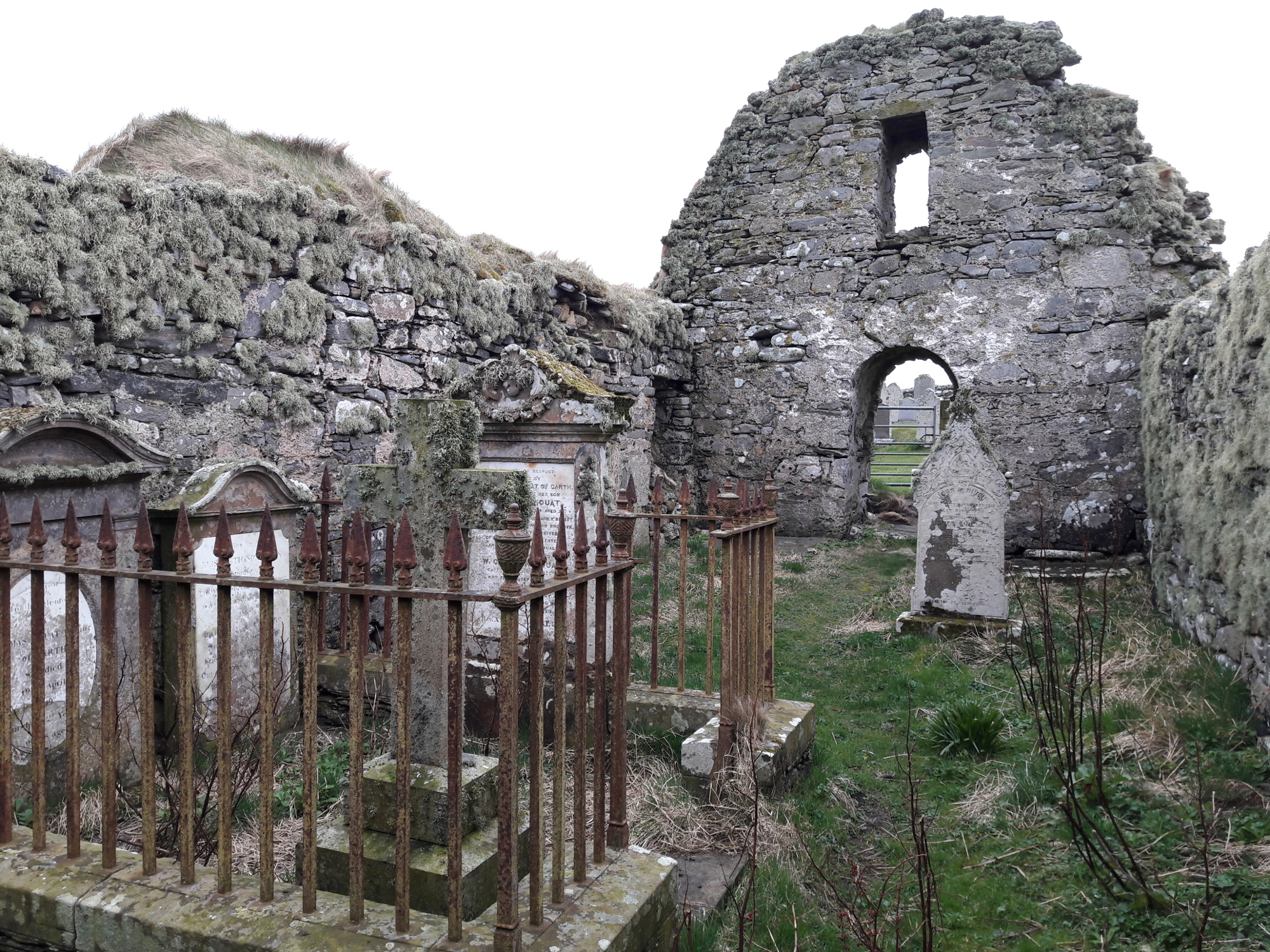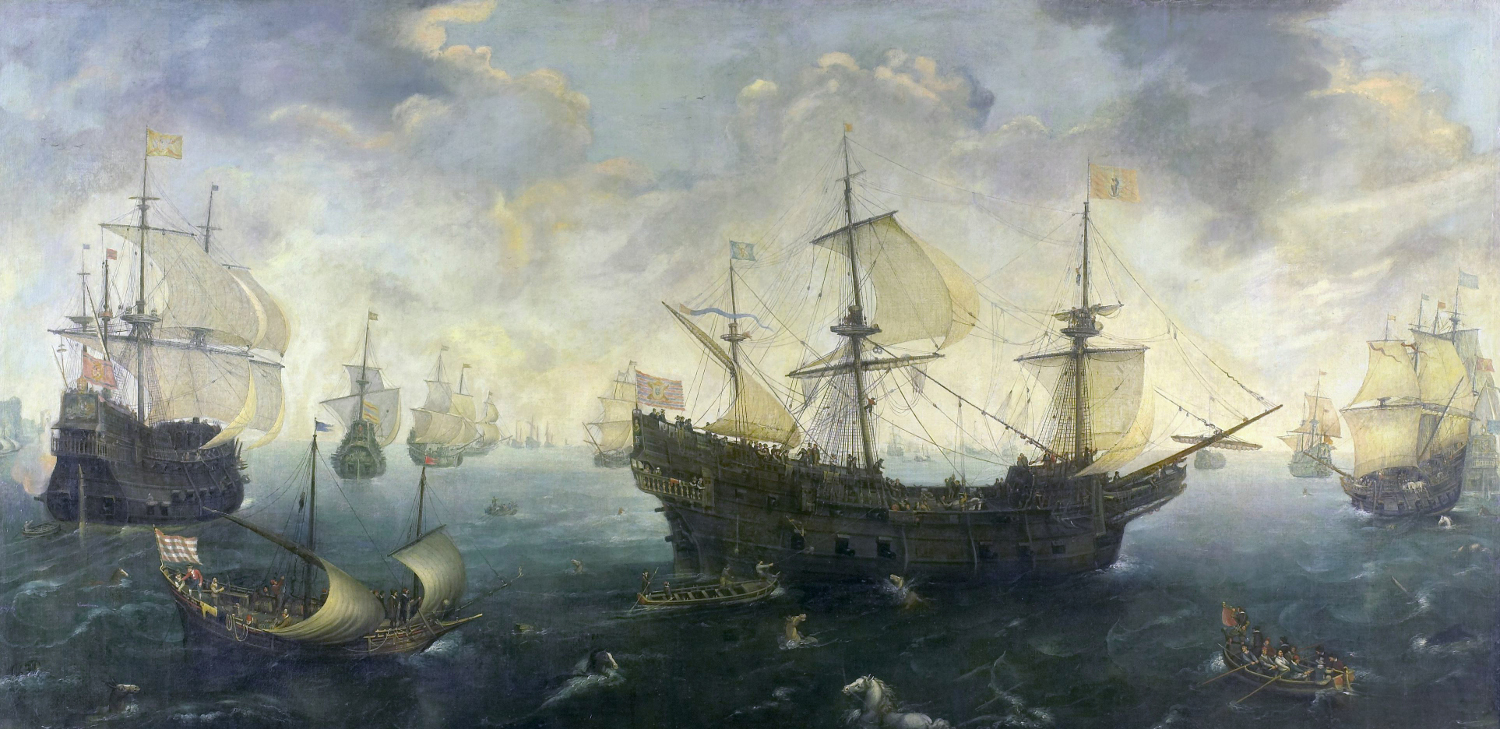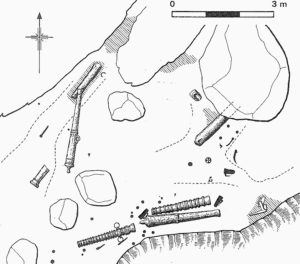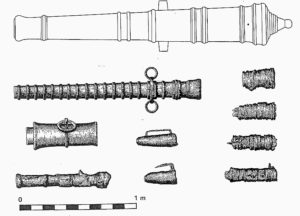A greasy business: the trade in Shetland butter
Bart Holterman, 18 December 2021
Among the commodities exported from the North Atlantic islands in the late Middle Ages and the Early Modern period, few are as enigmatic as butter. As rents and taxes were partly paid in butter on the islands, they frequently appear as a trade item in the dealings of the authorities or the church with foreign (German) merchants. However, the role of butter in the North Atlantic trade is not well understood.
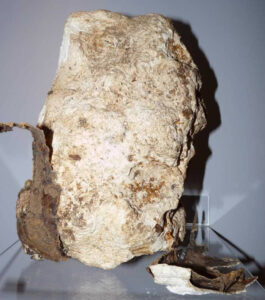
On the Carta Marina of Olaus Magnus of 1539, barrels of butter are displayed near the monastery Helgafell in Iceland, indicating the significant butter production of the Icelandic church (see the header image of this blog). Magnus described in his 1555 Historia de gentibus septentrionalibus that salted butter was produced in Iceland “partly for consumption at home, but more particularly for barter with merchants”. It is indeed known that German merchants bought butter in Iceland, but but they imported butter to Iceland as well, which is puzzling. Probably, this was butter of a different quality, but the sources do not say much about it. Butter exports are also known for the Faroes in the late 16th century.
Where the relevance of butter as a foreign exchange product was probably limited in Iceland and the Faroes, it seems to have played a much more prominent role in Shetland and Orkney. Especially in the 17th century, there are frequent mentions of German merchants buying butter from Shetland sheriffs, lairds or tacksmen. On many occasions, they even entered into considerable debts for taking the butter to Germany.
This is remarkable, given that the export butter from Shetland and Orkney does not seem to have been of a specifically good quality. Farmers kept the better quality “meat butter” for home consumption, whereas the butter with which taxes and rents were paid was the low quality “grease butter”, full of hairs and dirt, unfit for consumption. According to Gordon Donaldson, it “was fit only for greasing wagon-wheels”. It was exactly this grease butter that was sold abroad. Already in the 16th century, it is known that salted Orkney butter was sold very cheaply in Scotland.
On a more closer look, it seems that the German merchants in Shetland were not so keen on buying the Shetland butter, even though they bought it in considerable quantities. Various letters of the 17th century tell about the negotiations of Shetland tacksmen and the servants of lairds with German merchants about the price of butter. For example, James Omand wrote to Laurence Sinclair of Brugh in 1640 that he could only sell the butter to the Germans for a lower price than expected. Two letters from Andro Greig to the Baron of Brugh from 1655 mention his dealings with Hamburg merchant Otto Make, who was not interested in buying butter for the reason that he could not get a good price for it on the German market. The letters of the tacksmen Andro Smith to his brother Patrick from the early 1640s also speak of the difficulties he had with selling the butter to the German merchants; he had to sell the butter in Leith in the end.
Even more explicit is a letter from David Murray to Andrew Mowat from 1682, in which Murray instructs Mowat to “use all possible means” to make the German merchants take the Shetland butter. This included threatening them, although he also presses him “to deall civellie with them”.
All in all, it appears that Shetland officials did not always have an easy time trying to sell the butter abroad. It also remains the questions why the Germans took the butter with them after all, especially since good-quality butter was produced in northern Germany as well, for example in East Frisia. Were the Germans exaggerating and only playing hard-to-get to keep the prices low? Did they give in to the pressure that the Shetlanders put on them? Or did they perhaps feel obliged to take parts of the butter from their trading partners for fear of losing access to the much more profitable Shetland fish trade, even if they could only sell it at a loss? It seems that further research will be needed to solve this riddle.
References and further reading
Ballantyne, John H., and Brian Smith, eds. Shetland Documents, 1612-1637. Lerwick, 2016.
Donaldson, Gordon. Shetland Life under Earl Patrick. Edinburgh, 1958.
Fenton, Alexander. The Northern Isles: Orkney and Shetland. Edinburgh, 1978.
Holterman, Bart. The Fish Lands. German Trade with Iceland, Shetland and the Faroe Islands in the Late 15th and 16th Century. Berlin, 2020.
Posted in: General, Sources, Stories
Fish and Ships continues: new project about the international trade of Orkney and Shetland in the early modern period
Natascha Mehler, 27 March 2020
Over the past years, our research on the German trade with the North Atlantic islands has mainly focused on the exchange with Iceland. In the case of Shetland, however, much written and archaeological material exists which is of great potential to help uns understand the operation of international trade on the North Atlantic island. We therefore, we applied for a new grant in order to continue our work with Shetland. The project also addresses the question whether Orkney, which shares many characteristics with the other islands but hardly ever appears in the written sources, was also visited by German merchants in search of dried fish and if they did, to what extent and how this trade was organised. Finally, we will broaden our view to include other international (English, Dutch, Norwegian) traders in the area.
We are happy to announce that our team, together with other archaeologists and historians from the University of the Highlands and Islands Archaeology Institute and the University of Lincoln have been awarded a grant of c. 900.000 Euros from the Arts and Humanities Research Council (AHRC) and the German Research Foundation (DFG) to do this. Over the next three years, the members of the project “Looking in from the edge (LIFTE)” will look at a number of early modern documents, objects from archaeological excavations and also conduct fieldwork in Orkney and Shetland. This also means that we will continue blogging on Fish and Ships for more stories and short research reports about pre-modern trade in the North Atlantic. Stay tuned!
Here are the links to our announcements in English and in German, with further information.
https://www.dsm.museum/pressebereich/der-lange-arm-der-hanse/

Posted in: Announcements, General
Till death do us part: Graves of sixteenth-century German merchants in the North Atlantic
Bart Holterman, 11 October 2018
When one has the chance to visit the northernmost island of Shetland, Unst, it is worth visiting the ruined church at Lunda Wick, in a bay to the Southwest of the isle. To get there, one has to take a small gravel road across a barren moory landscape where nothing seems to live but sheep and the occasional marsh bird. At the end of the path, one reaches a secluded bay where the grey waves and the rain torture the sands of the beach, and out of the fog a ruined medieval chapel appears with a graveyard around it. Inside the roofless chapel are a number of old tomb stones, the text made almost illegible by the lichen that overgrows them and centuries of rain and salty sea wind. In a corner lies a grave slab, on which it is possible to discern a text written in Low German, with great difficulty: “Here lies the honourable Segebad Detken, citizen and merchant from Bremen, who has traded in this country for 52 years, and died [in the year 1573], the 20th of August. God have mercy on his soul” (see below for the Low German text).
Segebad Detken is known from written sources about the Bremen trade with Shetland. He can be tracked from 1557 onwards as a skipper in the northern harbours Burravoe in Yell, and Baltasound and Uyeasound in Unst. In 1566, he was robbed by Scottish pirates in the harbour of Uyeasound. As his tomb slab mentions that he had been trading for 52 years in Shetland, he must have died in the late 16th century (see below). After his death, his relatives took over the business: among others his son Herman and grandson Magnus are recorded as merchants in northern Shetland in the early 17th century.
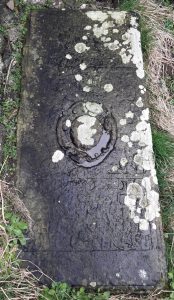
The grave slab of Segebad Detken in the ruined church in Lunda Wick. Photograph: Bart Holterman, 2018.
Given the long careers of German traders in the North Atlantic, and the fact that Bremen and Hamburg merchants dominated this trade for over 100 years (for Shetland even longer), it is not surprising that some of these merchants were buried on the islands when they died there. We can find another example just a bit outside the same church. There is another grave of a contemporary of Segebad Detken, that of his fellow citizen Hinrick Segelken. The Low German text on his slab translates as: “In the year 1585, the 25th of July, on St James’ day, the honourable and noble Hinrick Segelcken the Elder from Germany and citizen of the city of Bremen, died here in God our Lord, who has mercy on him.”
The tombstones were most probably imported by the German merchants, as the sandstone from which they were made is not available on the islands. By erecting a distinct grave marker for their deceased colleagues, they did not only honour their remembrance, but it also served to strengthen their ties with the local communities. The material and textual aspects of the monuments reminded the observer of the importance of the German merchants for the local economy, even across the boundaries of life and death.
A similar situation we find on Iceland, where we can also find tombstones of German merchants. The National Museum of Iceland in Reykjavik, for example, houses the tomb slab of Bremen merchant Claus Lude (follow link for an image), who was originally buried in the monastery Helgafell on the Snæfellsnes peninsula. The stone shows his house mark, a seal with two crossed stockfishes, and a text which mentions that he died on 3 June 1585. Lude is known to have been active in harbours in Snæfellsnes in the 1550s, and held a license for the harbour Grindavík in 1571.
In southern Iceland, at the graveyard of the former monastery Þykkvabær, one can still find the tombstone of Hans Berman the Younger from Hamburg, who died in 1583. The monastery records reveal that he was administrator of the monastic property (klausturhaldari) and was killed by the parish priest of Mýrar. His name also appears in the register of the Confraternity of St Anne of the Iceland merchants in Hamburg, where another Hans Berman (probably his father) was elderman around the same time.
In Hafnarfjörður near Reykjavík, the Hamburg merchants had their headquarters and also erected their own church. It is likely that they also had a graveyard where they buried their dead. During construction of the modern harbour of Hafnarfjörður in the 1940s, human bones were found which many believed to be from the old German graveyard in the town. It might even be possible that these bones once belonged to Hamburg merchant Hans Hambrock, the only death of a Hamburg merchant in Hafnarfjörður known from the written record. Hambrock had died from the injuries inflicted upon him by his colleague Hinrick Ratken, who drew his knife against him after Hambrock had hit Ratken on the head during a conflict about the unloading of a ship in 1599. Regrettably, the remains of the German church in Hafnarfjörður are now buried below the modern town.
Inscriptions on the discussed tombstones
Lunda Wick, Shetland
Segebad Detken: “HIR LIGHT DER EHRSAME / SEGEBAD DETKEN BVRGER / VND KAUFFHANDELER ZU / BREMEN [HE] HETT IN DISEN / LANDE SINE HANDELING / GEBRUCKET 52 IAHR / IST [ANNO 1573] DEN / 20 AUGUSTI SELIGHT / IN UNSEN HERN ENT / SCHLAPEN DER SEELE GODT GNEDIGH IST.”
Hinrick Segelcken: “ANNO 1585 DEN 25 IULII / UP S. JACOBI IS DE EHRBARE / UND VORNEHME HINRICK / SEGELCKEN DE OLDER UTH / DUDESCHLANT UND BORGER / DER STADT BREMEN ALHIR / IN GODT DEM HERN ENTSCHL / APN DEM GODT GNEDICH IS.”
Helgafell, Iceland
Clawes Lude: “Anno 1585 de.3. Junius starff clawes lüde van Bremen der olde. Dem godt gnedich seij.”
Þykkvabær, Iceland
Hans Berman: “HIR LICHT BEGRAVEN SALICH HANS BIRMA[N] D:I:V:H [i.e. “De Junger van Hamborg”] ANNO 1583.”
Further reading
Hofmeister, Adolf E. Sorgen eines Bremer Shetlandfahrers: Das Testament des Cordt Folkers von 1543. Bremisches Jahrbuch 94 (2015): 46–57.
Holterman, Bart. The Fish Lands. German Trade with Iceland, Shetland and the Faroes in the Late 15th and 16th Century. PhD thesis, Universität Hamburg, 2018.
Koch, Friederike Christiane. Das Grab des Hamburger Hansekaufmanns Hans Berman/Birman in Þykkvibær/Südisland. Island. Zeitschrift der Deutsch-Isländischen Gesellschaft e.V. Köln und der Gesellschaft der Freunde Islands e.V. Hamburg 5.2 (1999): 45.
MacDonald, George. More Shetland Tombstones. Proceedings of the Society of Antiquaries of Scotland 69 (1934): 27–48.
Newspaper article: Reger Handel mit dem hohen Norden
Bart Holterman, 7 September 2017
Bart Holterman presentated the project and his own research on August 5 in Haus der Wissenschaft in Bremen. Matthias Holthaus was there as well and wrote the following article about it in the Weser Kurier of August 21, which gives a nice overview of the situation German merchants had to deal with when trading in the North Atlantic in the late Middle Ages (in German).
Posted in: Press
El Gran Grífon – The story of a Hanseatic ship in the Spanish Armada, wrecked in Shetland
Philipp Grassel, 29 June 2017
In the 15th to 17th centuries, the North Atlantic Islands of Shetland, Faroe and Iceland were frequently visited by Hanseatic merchants, who usually made one voyage each year. The trading season started roughly in April and finished in August/September and because of its regular character, we have much information about the number of Hanseatic ships sailing North each year.
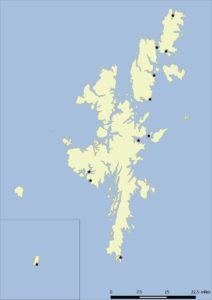
Map of the Shetland Islands with the positions of Hanseatic ship losses. Fair Isle and the wreck of the Gran Grífon can be seen in the smaller map (map created by P. Grassel)
In the middle of the 16th century, on average 5 ships per year from Bremen and 1 or 2 ships from Hamburg travelled to Shetland. Contemporary sources from 1560 speak of a minimum of 7 ships from Bremen and Hamburg in Shetland harbours. In Iceland, the numbers were even higher. For example in 1585, 14 ships from Hamburg alone and 8 ships from Bremen, Lübeck and Danzig reached Icelandic harbours, and in 1591 as many as 21 ships from Hamburg arrived in Iceland. In spite of these high numbers of voyages and some documented losses of Hanseatic ships – there are at least 10 known losses around Shetland and 3 losses around Iceland – no wrecks or remains of Hanseatic trading ships in the North Atlantic were found yet.
However, this does not mean that there are no Hanseatic trading vessels to be found in the North Atlantic at all. The only wreck which could be considered as Hanseatic are the remains of the El Gran Grífon (The great Griffin). This ship, which is the oldest known wreck both in Shetland and of all the North Atlantic islands, has a quite unusual history.
As the name already suggests, the Gran Grífon did not end up in Shetland by merchants from Bremen or Hamburg. Instead it was part of the famous Spanish Armada. This was a Spanish fleet which was sent in 1588 by the Spanish King Philipp II to invade England. The operation was a complete failure; the bulk of the fleet was lost after attacks by the English Navy and subsequent bad weather conditions on the North Sea.
The Gran Grífon itself was a former Hanseatic merchant vessel from Rostock, a Hansa Town in the Baltic Sea, and was bought by the Spanish Navy for the Armada. This was not unusual; merchant ships were in this time often converted for military use in times of war. After the ship had been roughly modified, it was used as the flagship for a squadron of 23 supply and troop ships. These poorly armed squadrons, called urca squadrons, consisted of acquired merchant vessels and were commanded by Juan Gomez de Medina. The ship had a tonnage of 650 tons, a length of around 30 m and an armament of 38 unspecified cannons. The original crew of 43 men were supplemented with around 200 soldiers. So all in all carried the ship over 243 men.
After some battles with the English Navy, which took the lives of over 40 soldiers and seamen, the ship was driven to the North of the British Isles. It was accompanied by other Armada vessels like the Barca de Amburgo (probably another converted Hanseatic ship from Hamburg), Castillo Negro and La Trinidad Valencera. After the Barca de Amburgo sank, the Gran Grífon and the Trinidad Valencera took over the surviving men.
Shortly afterwards the contact between the ships was lost and the Gran Grífon sailed in a South-West direction, trying to get back to Spain through the Atlantic. However, after the ship reached the latitude of the Galway Bay in Western Ireland, a strong gale from the South-West got up and flouted the Ship back North. Since the ship was heavily damaged, Juan Gomez de Medina decided to search for the nearest possible land. This turned out to be Fair Isle, the most southern and remote island of the Shetland archipelago. The ship tried to anchor in vain before it was driven ashore and ended up on a cliff at Stroms Hellier at the Southeastern end of the island in September 1588. Most of the remaining crew members and soldiers, including Gomez de Medina, managed to escape from the ship before it disappeared in the waves.
For a long time, the wreck remained untouched in the 9-18m deep water. In 1728, W. Irvine salvaged three cannons from the wreck. An archaeological excavation was carried out between 1970 and 1977 by the Institute of Maritime Archaeology of St Andrews University, led by C. Martin. Unfortunately the wreck was barely preserved. Parts of the stern, a rudder pintle, cannons of different sizes, coins, cannon balls, musket bullets and lead ingots were found, recorded and removed. Other, smaller finds like the handle of a pewter or “Hanseatic” flagon, as well as a curved iron blade, were also recovered. The wooden part of the stern was preserved under a boulder, which had tumbled down from the nearby cliff. Most of the finds were brought to Lerwick, where they can be partly seen at the Shetland Museum.
Further reading:
K. Friedland, Der hansische Shetlandhandel, in: K. Friedland, Stadt und Land in der Geschichte des Ostseeraums (Lübeck 1973) 66-79.
C. Martin, Cave of the Tide Race – El Gran Grifon, 1588, in: C. Martin, Scotland’s Historic Shipwrecks (London 1998) 28-45.
P. Grassel, Late Hanseatic seafaring from Hamburg and Bremen to the North Atlantic Islands. With a marine archaeological excursus in the Shetland Islands, Skyllis. Zeitschrift für marine und limnische Archäologie und Kulturgeschichte, 15.2, 2015, 172-182.
